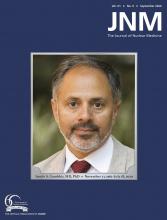Remembering Gambhir: Phelps and Herschman look at the extraordinary life and contributions of Sanjiv (Sam) Gambhir, MD, PhD, in nuclear and molecular medicine practice, research, education, and leadership.
Page 1273
Discussions with leaders: Thomas Hope talks with Joseph R. Osborne, professor of radiology and chief of molecular imaging and therapeutics at Weill Cornell Medicine and director of the Molecular Imaging Innovations Institute for Inclusion.
Page 1275
COVID-19 and global nuclear medicine: Freudenberg and a multinational team of researchers report on the results of a survey on the early impact of the COVID-19 pandemic on nuclear medicine, with respondents from 72 countries.
Page 1278
State-of-the-art SPECT/CT: Van den Wyngaert and colleagues offer an overview of the most recent developments in SPECT/CT instrumentation, radiopharmaceuticals, and techniques and their expanding clinical utility in precision medicine, including theranostics.
Page 1284
Old tools, new applications: Li and Roach provide perspective on the utility of the Roach equation, introduced in the 1990s for estimation of lymph node involvement in prostate cancer, in the modern imaging era.
Page 1292
18F-FET PET in glioma resection: Filss and colleagues evaluate pre- and postoperative 18F-FET PET scans of cerebral glioma patients to detect reactive changes in uptake, including a “flare” phenomenon, in the resection cavity.
Page 1294
Radiolabeled mAb BC8: Matesan and colleagues review 111In-DOTA-anti-CD45 antibody imaging and bone marrow biopsy metrics to determine human biodistribution and biokinetics and to investigate differences based on type of hematologic malignancy.
Page 1300
PET/CT in pediatric PTLD: Montes de Jesus and colleagues report on the diagnostic performance of 18F-FDG PET/CT in detection of posttransplantation lymphoproliferative disorder in a pediatric population and explore its feasibility during response assessment.
Page 1307
PET/ultrasound-guided prostate biopsy: Liu and colleagues research the potential and diagnostic efficacy of 68Ga–prostate-specific membrane antigen PET/CT combined with PET/ultrasound-guided biopsy in the diagnosis of prostate cancer with previously negative biopsy findings.
Page 1314
18F-DCFPyL PET uptake: Jansen and colleagues explore the repeatability of quantitative PET/CT measurements using this second-generation 18F–prostate-specific membrane antigen ligand in patients with prostate cancer.
Page 1320
PRRT and esthesioneuroblastoma: Kamel Hasan and colleagues report on efficacy and survival outcomes with peptide receptor radionuclide therapy in patients with this rare malignancy.
Page 1326
Lower GI 68Ga-FAPI PET/CT: Koerber and colleagues evaluate the role of fibroblast activation protein inhibitor PET/CT as a first clinical analysis for primary malignancies within the lower gastrointestinal tract.
Page 1331
177Lu-DOTATATE in vivo stability: Lubberink and colleagues assess the in vivo stability of 177Lu-DOTATATE using blood sampling and high-performance liquid chromatography in patients with neuroendocrine tumors undergoing peptide receptor radionuclide therapy.
Page 1337
Neurocognitive networks in dementia: Ripp and colleagues use simultaneous resting-state functional MRI and 18F-FDG PET imaging to look at network integrity in individuals with mild Alzheimer disease or behavioral-variant frontotemporal dementia.
Page 1341
PET imaging of NKp30: Shaffer and colleagues detail the development and preclinical validation of 2 antibody-based PET probes specific for NKp30, an activation natural cytotoxicity receptor expressed by human natural killer cells.
Page 1348
Interleukin-2 radiotracers for PET: van der Veen and colleagues describe the development of 2 radiolabeled interleukin-2 variants and compare their in vivo and in vitro characteristics with those of 18F-FB-IL2 for T-cell imaging.
Page 1355
Acidosis and pH-targeted PET: Henry and colleagues investigate whether PET imaging using hydrophobic cyclic peptides that partition into the cellular membrane at low extracellular pH can permit accurate in vivo visualization of acidosis associated with innate immune activation.
Page 1361
18F-Galactodendritic PET/CT: Pereira and colleagues detail radiolabeling of a dendritic galactose carbohydrate with 18F and examine its potential with preclinical imaging studies of urothelial malignancies.
Page 1369
Alignment of PET and CT: Hamill and colleagues introduce a novel approach for improving respiratory alignment of anatomic features between the CT and PET components of whole-body PET/CT imaging.
Page 1376
Solid-state SPECT/CT 177Lu quantitation: Kennedy and colleagues compare in vivo results for a digital solid-state cadmium-zinc-telluride SPECT/CT system with those from in vitro sampling to determine the accuracy of 177Lu-radiotracer concentration measurements using quantitative clinical software.
Page 1381
Deep learning for PET image denoising: Sanaat and colleagues assess the performance of full-dose PET image synthesis in both projection-image space and projection-scale space using deep learning techniques and low-dose PET images and sinograms without sacrificing diagnostic quality.
Page 1388
Data-driven head motion correction: Lu and colleagues propose and test a motion correction framework with a data-driven algorithm using PET raw data to address limitations of current correction methods.
Page 1397
- © 2020 by the Society of Nuclear Medicine and Molecular Imaging.







